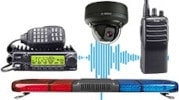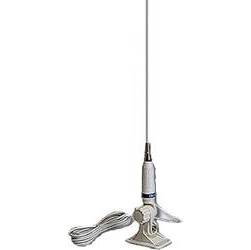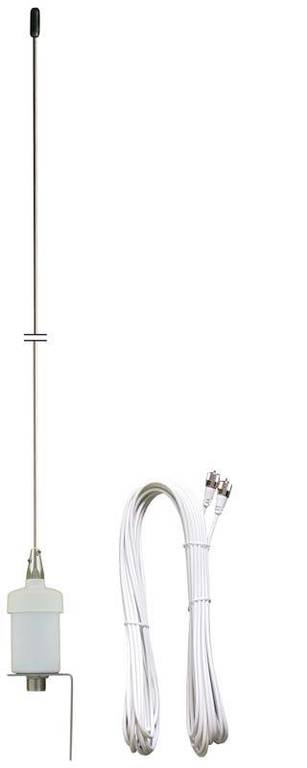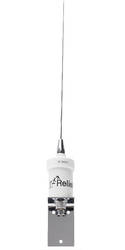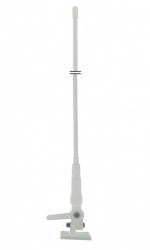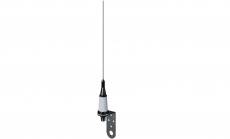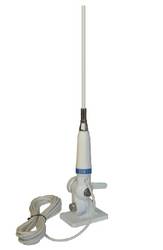Marine Antennas
- further categoriesThe ship's antenna is an important part of the communication system of a vessel. There are many choices for reliable communication between vessels or with land, but for boaters, VHF and CB antennas offer the best choice. Read more...
• Type: 1/2 λ
• Frequency range: 156 - 162.6 MHz @ SWR ≤2
• Impedance: 50Ω
• Radiation (H-plane): 360° omnidirectional
• Radiation (E-plane): beamwidth @ -3 dB= 60°
• Radiation anlge deg.: 23°
• Polarization: linear vertical
• Gain: 0 dBd - 2.15 dBi
• Max. Power (CW) @ 30°C: 100 Watts
• Grounding protection: All metal part are DC-grounded, the inner conductor is coupled capacitively
• Cable Length / Type: 5.5 m / white RG 58 C/U
• Standard mount: "M-8" NY
• Frequency: 156-162 MHz
• Channel number: 600
• Maximum output power: 100W
• S.W.R.: 1,1:1,5
• Gain: 3dB
• Length: 100cm
• Material: stainless steel
• Supplied 18 m RG-58 cable and 2 x PL 259 connector
• Frequency: 156-162 MHz
• Channel number: 600
• Maximum output power: 100W
• S.W.R.: 1,1:1,5
• Gain: 3dB
• Length: ~150cm
• Material: glass fibre
• Supplied cable: 4m RG-58
• Antenna connector type: SO-239 (socket)
• Removable style, can be release for easy adjustment
• Type: 1/2 λ
• Frequency range: 156 - 162 MHz @ SWR ≤1.5
• Impedance: 50Ω
• Radiation (H-plane): 360° omnidirectional
• Radiation (E-plane): beamwidth @ -3 dB= 60°
• Radiation anlge deg.: 23°
• Polarization: linear vertical
• Gain: 0 dBd - 2.15 dBi
• Max. Power (CW) @ 30°C: 100 Watts
• Grounding protection: All metal part are DC-grounded, the inner conductor is coupled capacitively
• Frequency: 156-162 MHz
• Gain: 3dB
• Length: 0,9 m
• Material: stainless steel
• Connector: PL259 female
• Mount: complete with "L"-type mounting bracket
• Supplied 5 m RG-58 cable and 2 x PL259 connector
• Type: Base loaded
• Frequency range: 26-28 MHz No tuning required
• Systems: CB 27MHz
• Radiation: Omnidirectional
• Polarization: Linear vertical
• Bandwidth: ≥ 5.6MHz @ SWR ≤ 2
• Max Power: 15 Watts (CW) continuous; 50 Watts (CW) short time
• Grounding protection: DC-Ground
• Cable lenght / type: 5 m / White RG58
• Materials: Chromed brass, Fiberglass, Nylon
• Height (approx): 1505 mm
• Weight (approx): 720 g
• Mounting type: Thru-Holes
• Connector: Not supplied
Because a good boat antenna is just as important to your watercraft or yacht as a good quality radio. But a modern sailboat should also be equipped with a proper boat antenna. These antennas are made of high-quality stainless steel, fibreglass or elastic rubber, depending on the manufacturer.
What frequencies are supported by the boat antennas available in the DND webshop?
The DND Telecom webshop offers boat antennas from the Sirio, Albrecht and Nautica brands. The VHF type antenna has a frequency of 156-162 MHz and the CB boat antenna has a frequency of 26-28 MHz. The latter does not require tuning, which makes it easier to install.
How do I choose the right boat antenna for my boat type?
An antenna is a device that receives signals via radio frequency. However, there is a golden rule to keep in mind when buying a boat antenna, A boat antenna is used on the water and differs from its land-based cousins in a few key ways. First, the design of the boat antenna must be able to withstand the harsh water conditions. It is important to buy an antenna that is truly designed for wet conditions.
These special requirements tend to make this type of equipment more expensive, but a boat antenna can save lives, so it's important not to skimp on this. Because safety comes first. We should choose an antenna with an eye to the size of the vessel, where it will be used and how far from shore it will be used.
But when buying, also look for high performance and long life. If you're looking for a boat antenna for a powerboat or sailboat, a lightweight, compact VHF boat antenna is a great choice.
What is the range of boat antennas?
VHF boat antennas are made of stainless steel or fiberglass and come in a variety of types and lengths. Improper selection of a VHF antenna can affect its overall performance. When purchasing this type of antenna, the following considerations should be taken into account: the dB rating and the height of the antenna. Because the higher the antenna, the better the reception.
How is a boat antenna installed and what tools does it require?
Installing a boat antenna is not a complicated task, but you need to coordinate its operation with the boat's radio and make sure that the grounding is done properly. Therefore, it is better to leave the installation of the boat antenna to a professional. The experienced staff at the DND Telecom webshop will install your boat antenna quickly and professionally. Ask for our offer!
What safety measures should be taken into account when using an antenna?
Your boat can be struck by lightning. Since the antenna must be placed at the highest point of the boat, lightning will strike the antenna, which, if not properly grounded, can destroy other electronics connected to it, such as the radio, which could even save lives. Since the boat cannot ground the electronics, the antenna must be double insulated.
Are there any special maintenance requirements for boat antennas?
Hull and deck cleaning is an almost daily task. For this, use a universal and highly concentrated boat shampoo. It makes the surface shiny and has a water-repellent effect. As such cleaners can be used on all plastic and lacquered surfaces, it is safe to use them for cleaning the antenna as part of your daily routine. It is worth checking the antenna every six months to ensure that the antenna itself and the connectors are in perfect condition.
What type of connectors do boat antennas use and are they compatible with other equipment?
For maximum range and efficiency, VHF boat antennas have stainless steel ferrules that can withstand the elements. You can get even better reception with the antenna by connecting an amplifier to it. The boat antenna can also be connected to Class A and B transceivers, AIS transponders, mobile devices, VHF boat radios, satellite systems, and NOAA weather radar stations.
One other important detail to note about boat antennas is that for maximum signal strength, always place the boat antenna at the highest point on the watercraft!

